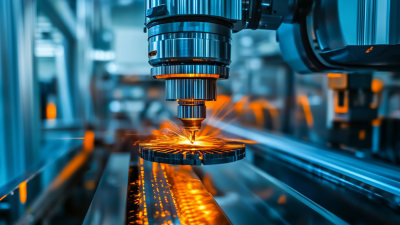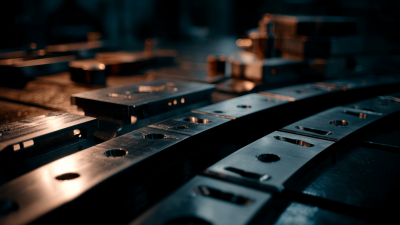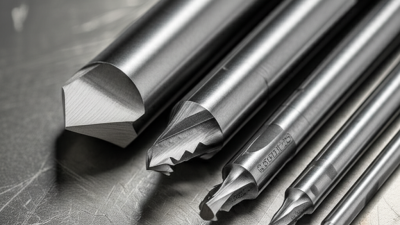In the rapidly evolving landscape of modern manufacturing, the significance of Tool and Die Design cannot be overstated. As industries strive for efficiency and precision, the quality of tools and dies directly influences production outcomes. Renowned expert in the field, John Smith, once stated, "The foundation of any successful manufacturing process lies in the meticulous design of tools and dies, as they dictate not only the quality of the end product but also the efficiency of production lines." This statement underscores the essential role that Tool and Die Design plays in optimizing manufacturing processes.

With the advent of advanced technologies such as computer-aided design (CAD) and precision machining, the potential for innovation in Tool and Die Design has expanded greatly. Companies that prioritize the development of cutting-edge tools and dies are better positioned to meet the demands of a competitive market. This article will explore the "Top 5" impacts of Tool and Die Design on modern manufacturing processes, revealing how strategic design decisions can lead to enhanced productivity, reduced waste, and improved product quality.
Through a deeper understanding of these aspects, manufacturers can unlock new levels of operational excellence, setting the stage for sustainable growth in the industry.
In modern manufacturing, tool and die design plays a crucial role in enhancing production efficiency. Advanced design techniques allow manufacturers to develop tools that are not only precise but also versatile, reducing production time and increasing throughput. According to a report by the Nationale Institute of Standards and Technology (NIST), effective tool design can improve manufacturing efficiency by as much as 30%. This is particularly significant in industries such as automotive and aerospace, where precision and reliability are paramount.
Tips for achieving optimal tool and die efficiency include investing in simulation software to test designs before production. This approach can significantly reduce the time spent on prototyping and iterations. Additionally, regular maintenance of tools and dies is essential; equipment that is well-maintained can consistently produce high-quality parts and prevent costly downtimes.
Another key aspect is collaboration between engineers and operators during the design phase. When design and manufacturing expertise intersect, it leads to more practical designs that streamline operations. Research from the Society of Manufacturing Engineers (SME) indicates that companies engaging in collaborative design processes saw a 20% reduction in production errors, ultimately driving lower costs and higher quality outputs.
In modern manufacturing, the design of tools and dies plays a pivotal role in enhancing precision and durability, which are crucial for meeting the stringent demands of various industries. According to a recent report by the Metal Forming Industry Association, optimizing tool and die design can lead to a reduction in production time by up to 30% while simultaneously improving component accuracy by 20%. This highlights the importance of implementing key design principles, such as utilizing advanced materials and innovative geometries that facilitate better heat dissipation and wear resistance.
Moreover, incorporating finite element analysis (FEA) during the design phase allows manufacturers to simulate and analyze the performance of tools and dies under different conditions. A study published in the Journal of Manufacturing Science and Engineering found that companies using FEA reported a 25% decrease in tool failures and an increase in lifespan by up to 40%. By focusing on these factors, manufacturers can significantly enhance both the performance and the longevity of their tools, thereby increasing overall production efficiency and cost-effectiveness in their operations.
The integration of advanced materials in tool and die design has revolutionized modern manufacturing processes, significantly impacting both tool longevity and production costs. Traditionally, tools were made from common materials that, while effective, often wore down quickly under the rigors of high-volume production. The introduction of advanced alloys, composites, and coatings has enhanced the hardness and resistance of tools to wear and thermal degradation. This means that manufacturers can expect less frequent tool replacements and maintenance interventions, leading to increased productivity and efficiency.
Moreover, the use of these advanced materials can lead to cost savings in the long run. Although the initial investment in high-performance tools may be higher, the extended lifespan and reduced downtime compensate for the spending. Additionally, manufacturers can achieve tighter tolerances and improved surface finishes, which not only enhances product quality but can also reduce the need for secondary operations. Consequently, integrating advanced materials into tool and die design is not just an innovation; it is a strategic approach that optimizes manufacturing efficiency and lowers overall production expenses.
| Material Type | Tool Longevity (cycles) | Production Cost ($/part) | Lead Time (days) | Heat Resistance (°C) |
|---|---|---|---|---|
| High-Speed Steel (HSS) | 200,000 | 0.50 | 14 | 600 |
| Carbide | 400,000 | 0.80 | 20 | 1000 |
| Cobalt Alloy | 350,000 | 1.00 | 18 | 800 |
| Ceramic | 600,000 | 1.20 | 25 | 1200 |
| Composite Materials | 500,000 | 1.10 | 22 | 950 |
In the automotive manufacturing sector, the significance of tool and die design cannot be overstated, as evidenced by various case studies showcasing successful implementations. According to a report by the Society of Automotive Engineers (SAE), optimizing tool and die processes can significantly reduce production costs by an average of 15%, while also minimizing material waste. An exemplary case involves a leading automotive manufacturer that redesigned their die-casting processes, resulting in a 20% increase in production efficiency and a dramatic reduction in cycle time. This transformation not only enhanced productivity but also allowed for greater design flexibility to accommodate evolving consumer demands.
Another compelling case can be found in the shift toward additive manufacturing techniques in tool and die design. A recent study published in the Journal of Manufacturing Science and Engineering indicates that integrating 3D printing technology in creating tooling systems has cut lead times by up to 50%. An automotive firm utilized this technology to produce a new set of stamping dies for a vehicle model launch. The ability to iterate designs rapidly enabled them to meet tight deadlines and achieve a 10% weight reduction in components, showcasing how innovative approaches in tool and die design can drive both efficiency and sustainability in modern manufacturing processes.
Investing in advanced tool and die technologies offers significant economic benefits that can enhance manufacturing efficiency and product quality. Modern manufacturing relies heavily on precise tooling solutions that not only reduce production times but also minimize material waste. With the latest advancements in computer-aided design and additive manufacturing, companies can create complex tool shapes that were previously unachievable, leading to shorter lead times and improved overall workflow.
Furthermore, the initial costs of upgrading to advanced tool and die systems can be offset by the long-term savings achieved through increased production rates and decreased rework. Automated and high-precision tools enable manufacturers to achieve tighter tolerances, resulting in higher-quality products that meet customer expectations. Additionally, by adopting these technologies, businesses can stay competitive in a rapidly evolving market, ultimately driving profits and fostering growth in the manufacturing sector.






